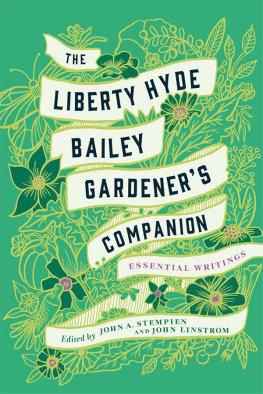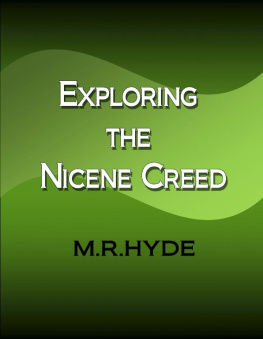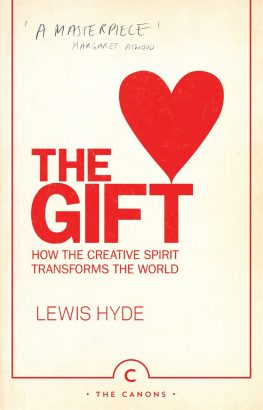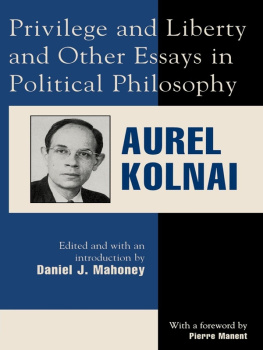Acknowledgments
This book has been, in many ways, some twelve years in the making. The number of people who have lent us their support, inspiration, and guidance during this process are too many to list. Both editors offer their deep and abiding thanks to Kitty Liu and the team at Cornell University Press for making this dream a reality; to the incredibly helpful and friendly archivists and staff at the Cornell University Rare and Manuscript Collections; to Kendra Millis, who compiled the index, and to the Department of English at New York University for enabling us to hire her; to John Bailey Page, for his support of this project and for his permission to publish several essays and images, the inclusion of which he dedicates in loving memory to his grandmother, Annette Sailor Page; and to the team of volunteers and board members at the Liberty Hyde Bailey Museum in South Haven, Michigan, who got us started by encouraging and supporting our work on Bailey for nearly a decade. Last, we wish to express our appreciation for Liberty Hyde Bailey:
If there be things I cannot tell
The more I trust that all is well.
John Stempien
Just as a plant is dependent on specific conditions to germinate from a seed, this book too required its own unique support to blossom. I would like to express my gratitude to Dr. Kristin M. Sylvian, Elaine C. Stephens, and Jane L. Taylor, all of whom were integral in introducing me to the life, work, and spirit of Liberty Hyde Bailey. Personally, I would like to thank John Linstrom, who helped in the encouragement and envisioning of this collections potential. I would also like to extend thanks to Paul English for his technical support during our sons hockey practice. I would like to recognize my late mother, Jeanette Stempien, as well as Don Raiche, who both provided the invaluable model of nature wisdom through their interactions with the plant world. Finally, I thank my family, Emma, Josh, and Michelle, for their love and support.
John Linstrom
Thanks first to my parents, Robert and Rebecca, for their unconditional support even of projects that have seemed far-fetched and a bit distant from the task at hand. I have always benefited from your patience, as I have flourished under your loving guidance. Thanks too to Ben and Sam, without whom I would be both a lesser and a less interesting human, and probably less able to find myself in improbable situations. An unmeasurable well of gratitude belongs to the community of Baileyphiles whom I have been privileged to meet over the years, clustered around Cornell University and scattered elsewhere across the country, for their generosity in providing direction to a graduate student in no way affiliated with them on paper: Kevin Armitage, Ed Cobb, Bill Crepet, Bob Dirig, Elaine Engst, Peter Fraissinet, Wes Jackson, Fred Kirschenmann, Kevin Lowe, Paul Morgan, Scott Peters, Daniel Rinn, Jane Taylor, and Gil Waldkoenig, among others. You have each been a model for me of unflinching academic integrity and unselfishness. Wendell Berry, the three hours I spent with you, when you showed me your marked-up copy of The Holy Earth and took me for a ride around the farm, were quietly but truly life-changing, and I will carry that visit with me for the rest of my life. For their understanding and leniency with an easily distracted doctoral candidate, as well as for their ongoing support and guidance in my academic life, I offer my deep gratitude to Una Chaudhuri, Sonya Posmentier, and Simn Trujillo. Thanks also to Mary Swander, my dear mentor and the creative force behind AgArts, and to the staff of Comstock Girl Scout Camp, for hosting me as their inaugural Bailiwick Writer-in-Residence, through the AgArts Farm-to-Artist Residency Program, at Baileys summer home on the site of his old farm on Cayuga Lake. That time was inspirational and essential, and Marys encouragement has fired up my Bailey work for close to a decade. For first introducing me to the joy and spice of Baileys vast corpus, I gladly offer my deepest thanks to my first and primary mentor in the swirling universe of Baileyana, now my good friend and the man with whom I am honored to be coeditor of this volume, John Stempien. The journey has been collaborative; we have made good jazz; but the seed, for me, came from you, and you watered it. And finally, Monique, your enthusiastic support has sometimes been baffling and overwhelming to me, and it has always been incredibly gracious and nourishing. I love you, you fill my life with marvels, and I look forward to many years of tending the garden with you.
Appendix I
The Garden Fence
Horticulture, the art, is old. It had its origin, with twin agriculture, in the fertile valleys of Asia, while yet the world was new. Man early learned to till the soil. He was a farmer. The earth gave him her fruitage. He selected and improved it. Generation after generation the slow increment of progress accumulated. The fruits of the first garden gave place to others. Gradually the old were lost, and the best were scattered to the four quarters of the globe with the early migrations of men. The history of many of our cultivated plants is almost a history of the human race. But with the gift of fruits, God sent other friends, disguised. Weeds originated when cultivation originated. There are no weeds where there is no cultivation. They are enforcers of duty. They early punished neglect with the consuming growth of tares. They have always been coercers of improvement. It is singular that we do not recognize this fact. Even Virgil was alert to it:
The father of human kind himself ordains
The husbandman should tread no path of flowers,
But waken the earth with sleepless pains.
So pricketh he these indolent hearts of ours,
Lest his realms be in hopeless torpor held.
.. All these things he did
That man himself, by pondering, might divine
All mysteries, and in due time conceive
The varying arts whereby we have leave to live.
Surely ours is a goodly heritage. Until our time has man improved upon nature, till the first parents of cultivated plants are lost, and we are bewildered with endless variety. If we cannot discover the devious path by which every fruit has come through the centuries, gathering here and there an element of that mysterious something which better fits it for the use of man, we can, nevertheless, enjoy an heritage which surpasses the hanging wonders of Babylon or the fabled gardens of the Hesperides. Perhaps we are approaching the limits of this development. Certainly our methods of cultivating are not essentially different from those which find record in Columella or in the verse of Virgil, methods which in essence were old when those authors wrote. The ancient art appears to have taken on a fixedness which is indicative of staid old age. We plough and sow and reap as did our fathers. If we reap more than they, it is chiefly because we have improved a little more in the line of their improvement. Surely here is not a field for the impetuous Yankee, who would conquer countries of which his father had never heard, who is irrepressible in any enterprise which promises profit, and demands business, brass and brains.
In 1795 a short and unpretentious article on grafting appeared in the Philosophical Transactions of England. The writer had observed that in England the most disastrous of the diseases of the apple and pear was the canker,a browning and dying of the younger shoots. It was the common opinion among orchardists that this disease is caused by a deterioration of the variety; the older varieties were running out. The writer opposed this view, and assumed that the disease had been conveyed, in each particular instance, by unhealthy scions. He conducted a series of experiments. He procured healthy young stocks, and grafted upon them the brightest and thriftiest scions he could secure from the cankered trees. When these had grown, he inserted the best scions which they afforded on other fresh seedling stocks. This progressive operation was repeated for six generations. Although he did not escape the canker, he found that he had hit upon a fertile trail. He satisfied himself that scions from old and worn-out trees are prematurely productive and short-lived, and reasoning from this he concluded that scions from very young seedlings would prove to be tardily productive and long-lived. Numerous experiments appeared to prove the proposition. Scions maintain their essential characters when set upon other stocks, or at least the characters of growth and fruitfulness. The graft will probably not endure long after the natural expiration of the tree from which the scion was taken. Probably most of the ancient varieties of apples had been propagated from scions from old and feeble trees, and, as a consequence, most of these fruits known to Parkinson and Evelyn had become extinct. The direct and impartial statements, the scientific methods, and the novelty of the subjects treated, at once brought the paper and its author into prominent notice.











